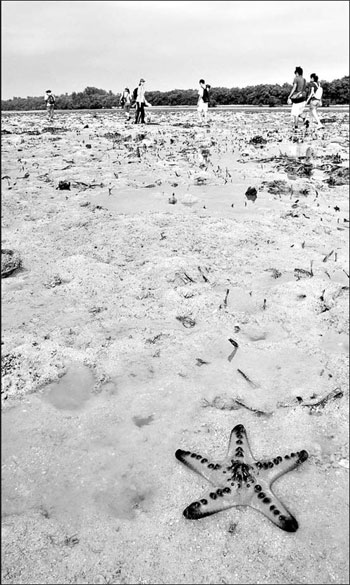On island of trash, a haven in nature
Updated: 2011-08-28 08:00
By Lindsey Hoshaw(The New York Times)
|
|||||||
|
Tidal pool walks are popular at the Semakau Landfill, which is home to more than 700 species of plants and animals, and some endangered species. National Environment Agency |
Singapore may have the only landfill with a four-month-long waiting list to visit.
But this landfill is a manmade island that resembles a nature preserve, despite the 8.9 million metric tons of incinerated waste just under the surface.
Singapore's land scarcity - its total area is under 700 square kilometers - has led the government to develop innovative waste disposal techniques. Among them is an island off the southern part of the mainland that opened after Singapore's last city dump closed in 1999. By joining two small islands, the government created Semakau Landfill, Singapore's first offshore dumping ground, and now a popular local getaway.
The $360 million facility includes a seven-kilometer-long sea wall and a geomembrane of polyethylene, which lines the island's periphery to prevent leakage. Incinerated trash from the mainland comes over in barges, and the wet ash is emptied into pits, or "cells," to eventually be covered over with dirt, where plants naturally take root.
Renovating landfills for public use is nothing new. In New York, the Fresh Kills landfill on Staten Island will reopen as a park around 2035. In 1994, Japan turned an old landfill southwest of Osaka into Kansai International Airport, the world's first ocean airport.
But Semakau Landfill is the only active landfill that receives incinerated and industrial waste while supporting a thriving ecosystem, which includes more than 700 types of plants and animals and several endangered species. "We want to keep this balance as long as possible," said Ong Chong Peng, the landfill's general manager.
Protected species like great-billed herons and Malaysian plovers nest there, and endangered Chinese white dolphins have been seen offshore. And Semakau is the only active landfill that encourages public visits.
This year, the island's eastern side is scheduled for development and may begin accepting waste as early as 2015. The National Environment Agency, which maintains the site, predicts that the landfill will stay open at least until 2045.
Fishermen come during the day and astronomers come at night. Tide pool walks, popular with school groups and others, are booked almost year-round.
The Singaporean government extols the success of Semakau, citing the increasing number of visitors, which has tripled in the last five years, to 13,000 in 2010. The National Environment Agency says the unique landfill system reduces the volume of waste by 90 percent, and says 2 percent of Singapore's power comes from energy generated by four mainland incinerators.
But critics question waste management that completely relies on incineration. Large-scale incinerators have short life spans, sometimes needing replacement after 10 years.
"Greenpeace is against waste incineration because it is a major source of carcinogenic substances like dioxin, as well as other harmful pollutants," said Tara Buakamsri, Greenpeace campaign director for Southeast Asia.
Protests in Malaysia and Indonesia have arisen over government plans to construct new incinerators, and the Philippines banned incinerators in 1999 because of health risks.
There is also the small risk that the waste will leak. Protective measures "will ultimately fail, posing a risk for future generations," said Scott Kaufman, United States senior manager at Carbon Trust, a British nonprofit group that seeks to help companies cut carbon emissions.
Environment agency officials say that TuV SuD, an international inspection firm, tests the surrounding water for heavy metals each month. They are confident the landfill can safely accept waste for decades.
"If we run out of landfill space," Mr. Ong said, "we're in trouble."
The New York Times
(China Daily 08/28/2011 page10)
